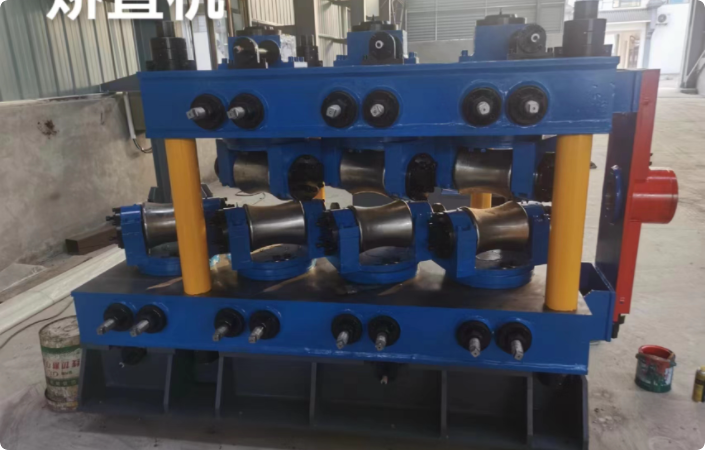Sheet Metal Alignment and Correction Equipment for Precision Manufacturing
The Importance of Sheet Metal Straightening Machines in Modern Manufacturing
In the realm of modern manufacturing, efficiency and precision are paramount. One of the integral processes in metal fabrication is the straightening of sheet metal, which ensures that the materials used in various applications meet the stringent requirements set by engineers and designers. At the heart of this process lies the sheet metal straightening machine, a vital piece of equipment that plays an essential role in the production line.
Sheet metal is utilized across numerous industries, including automotive, aerospace, and construction. Throughout these sectors, the quality of the final product often hinges on the integrity of the raw materials. When sheet metal experiences deformation during production, transportation, or processing, it can lead to significant issues such as poor fit, increased assembly time, and ultimately compromised structural integrity. Consequently, the need for effective straightening solutions has become increasingly critical.
Sheet metal straightening machines are specifically designed to correct imperfections in the sheet metal, such as bends, twists, and warps. These machines typically utilize a combination of mechanical force and pressure to re-align the metal sheets into a flat, uniform state. The process can vary depending on the type of machine used. Common types include rollers, press brakes, and mechanical straighteners, each of which offer different advantages based on the specific demands of the task.
Roller straightening machines are particularly popular in industries dealing with larger and thicker sheets. These machines use two or more rollers to apply pressure along the length of the sheet, gradually reshaping it into a flat plane. This method is often preferred due to its ability to handle heavy materials without compromising their structural integrity. For thinner sheets, mechanical straighteners can provide a more precise solution, utilizing a system of controlled bends and pressure points to achieve the desired flatness.
sheet metal straightening machine

One of the significant advancements in sheet metal straightening technology is the incorporation of computer numerical control (CNC) systems. CNC technology allows for automated operation, enhancing the accuracy and repeatability of the straightening process. Operators can input specific parameters into the machine's software, enabling complex adjustments and ensuring that the correct pressure and angles are applied consistently. This not only improves the quality of the output but also reduces the likelihood of human error, which can be costly in terms of both time and material wasted.
Another important consideration in the operation of sheet metal straightening machines is the material being processed. Different metals have varying properties, such as tensile strength and ductility, which can affect the straightening process. Therefore, operators must have an in-depth understanding of these properties and adjust their techniques accordingly to avoid damaging the sheets. By mastering these variables, manufacturers can optimize their straightening operations and achieve high-quality results.
In the competitive landscape of manufacturing, businesses are continually seeking ways to enhance productivity and reduce costs. Implementing efficient straightening solutions not only streamlines the production process but also minimizes the need for rework and scrap material, leading to significant cost savings. Additionally, a well-straightened sheet metal component often translates to easier handling and assembly, further improving overall operational efficiency.
As industries continue to evolve and the demand for high-quality products increases, the role of sheet metal straightening machines will remain vital. Investing in advanced straightening technology and training personnel to operate these machines proficiently will be crucial for companies aiming to stay ahead in the market. By ensuring that their sheet metal is consistently flat and defect-free, manufacturers can uphold their reputation for quality and reliability in an ever-demanding environment.
In conclusion, sheet metal straightening machines are an essential component of modern manufacturing. They play a vital role in ensuring the quality and integrity of sheet metal, enabling industries to produce high-quality products efficiently. With advancements in technology and a deeper understanding of materials, these machines will continue to be instrumental in shaping the future of metal fabrication.
-
High Frequency Straight Seam Welded Pipe Production Line-BzZhou Xinghua Machinery Equipment Manufacturing Co., LTD.|Precision Welding, High EfficiencyNewsJul.30,2025
-
High Frequency Straight Seam Welded Pipe Production Line|BzZhou Xinghua|Precision Welding&EfficiencyNewsJul.30,2025
-
High Frequency Straight Seam Welded Pipe Production Line - BzZhou Xinghua|Precision Engineering&EfficiencyNewsJul.30,2025
-
High-Frequency Straight Seam Welded Pipe Production Line-BzZhou Xinghua Machinery Equipment Manufacturing Co., LTD.NewsJul.30,2025
-
High-Frequency Straight Seam Welded Pipe Production Line-BzZhou Xinghua Machinery Equipment Manufacturing Co., LTD.|Precision Manufacturing, High EfficiencyNewsJul.30,2025
-
High Frequency Straight Seam Welded Pipe Production Line-BzZhou Xinghua Machinery Equipment Manufacturing Co., LTD.|Precision Steel Pipe Manufacturing&Industrial EfficiencyNewsJul.29,2025


